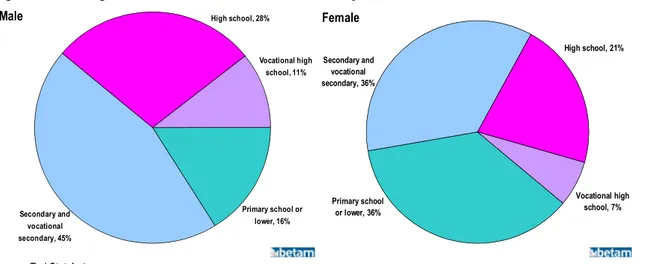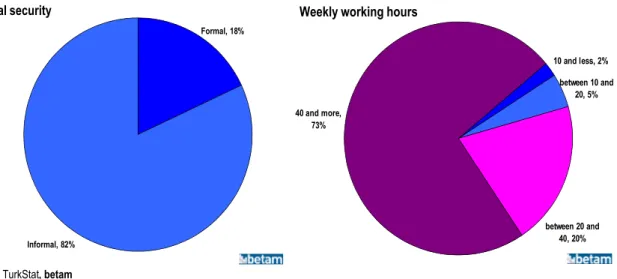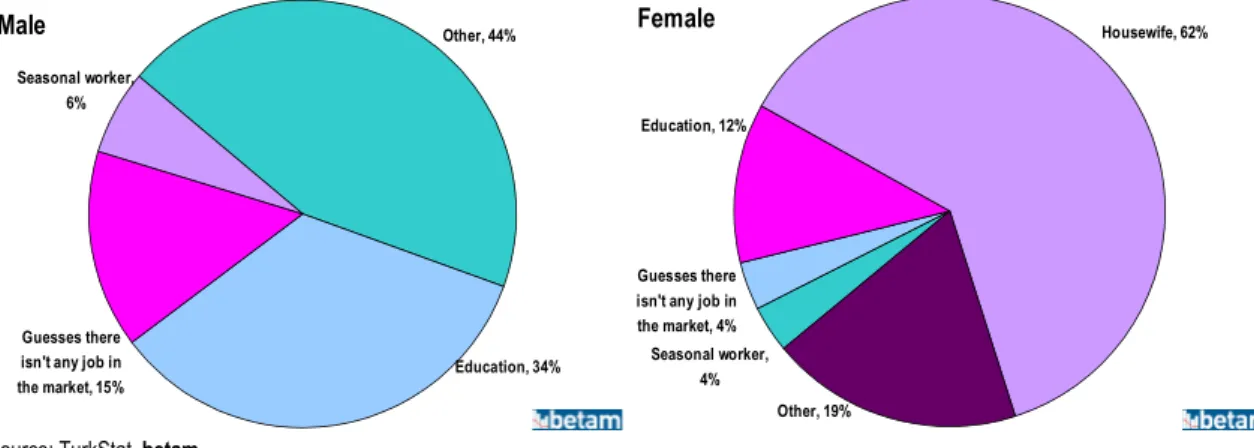1
Turkey is Losing its Young Generation
Mehmet Alper Dinçer**and Gökçe Uysal Kolaşin*
Executive summary
In Turkey, the schooling and labor force participation of 6.3 millions people in the age group 15-19 seems dire. 1.6 million young men and 1.9 million young women do not attend school. 61 percent of young males and 72 of young females who do not attend school did not proceed onto the high school. Those who are not in the labor market encounter unfavorable conditions. Most of them work 40 hours or more per week without social security. 17 out of every 100 are unemployed.
2 million, 600 thousand males and 1.4 million females, in the age group 15-19 neither go to school nor work. They are not even searching for a job. What is to be done? This generation, which will constitute the
backbone of human capital of the country in the 2020’s, can hardly respond to the needs of development. Unfortunately, Turkey does not have much time to answer this question and ameliorate the situation.
Young generation at the impasse
TurkStat collects data for the Household Labor Force Survey, surveying roughly 13 thousand households every month. Using TurkStat’s data, we look at the young population in the age group 15-19 paying particular attention to their schooling and labor force participation status. How many are in school, or are in the labor force? What are the working conditions for the young employed? What are those who left school and out-of -labor force doing? These questions are addressed below.
Most of those who left the school are not even high school graduates
There are 6.3 million people in the age group 15-19 in Turkey. 3.5 million of them, consisting of 1.6 million male (50 percent) and 1.9 millions female (61 percent), are not enrolled in school.(Figure 1)
The fact that most of those who are not enrolled in school have left it before graduating from the high school indicates a dire picture for the country. Majority of them dropped out of the education system prior to college or high school. 67 percent seems to have graduated from primary or secondary school.
**Mehmet Alper Dinçer, Research Assistant, alper.dincer@bahcesehir.edu.tr *Asst. Prof. Gökçe Uysal Kolaşin, Vice Director, gokce.kolasin@bahcesehir.edu.tr
Research Brief #007
2
Figure 1: Male and female population profiles
Male
Not in labor force and enrolled in
school, 45%
Not in labor force and not enrolled in school, 19% In labor force and
not enrolled in school, 31%
In labor force and enrolled in school, 5%
Female
Not in labor force and enrolled in
school, 37%
Not in labor force and not enrolled in school, 45% In labor force and
not enrolled in school, 16%
In labor force and enrolled in school, 2%
Source: TurkStat, betam
Of those who are not enrolled in scghool, 1 million out of 1.6 million young males and 1.3 million out of 1.9 million young female seem to have graduated from primary or secondary school. The difference between males and females is reflected at the high school level, as well. While 39 percent of males are high school graduates, the corresponding percentage for the female is 28 percent. (Figure 2)
The fact that 3.5 million out of 6.3 million has cut the cord with educational system and that 2.3 millions of them have only graduated from the primary or secondary school indicate a bleak prospect for the future.
Figure 2: Schooling status of male and female who are currently not enrolled
Male Secondary and vocational secondary, 45% Vocational high school, 11% High school, 28% Primary school or lower, 16% Female Primary school or lower, 36% High school, 21% Vocational high school, 7% Secondary and vocational secondary, 36%
Source: TurkStat, betam
Working conditions are tough
1.7 million in the age group concerned participate in the labor force. 200 thousand of them are both employed and students. 72 percent of the males and 26 percent of the females who left the school are either employed or look for a job. About 300 thousand of them (17 percent) are unemployed, which points to a higher rate than the total unemployment rate.
3 The young people face hard conditions in the labor market. 82 percent of 1.4 millions employed do not benefit from any type of social security. (Figure 3) Most of those hired in agriculture are unpaid household workers. Consequently, the percentage of those without social security in agriculture is as much as 99 percent. The corresponding figure for those hired in the non-agricultural sectors is 75 percent. Three out of four young hired in the manufacturing, construction and service sectors are unregistered.
73 percent of the employed are working 40 hours or more per week. This applies to 54 percent and 85 percent of those employed in agriculture and non-agriculture, respectively. The data on income indicates how much is earned by the young wage earners, salary earners and the daily-paid young laborers. 25 percent earn less than 100 YTL, while 87 percent earn less than 250 YTL a month (at 2006 prices).
Of course, the young college graduates hold higher value-added jobs earning higher wages. So the reasons for why the overwhelming majority of the young population leaves the school so early, giving up the future benefits of a college degree and accepting difficult working conditions, should be investigated.
Figure 3: Social security status and weekly working hours
Social security
Informal, 82%
Formal, 18%
Weekly working hours
40 and more, 73% between 10 and 20, 5% 10 and less, 2% between 20 and 40, 20% Source: TurkStat, betam
Two millions young idle
210 thousand males and 165 thousand females who are not enrolled in school declare that they are not actively searching for a job because they have not finished their schooling. Most of them are likely to study for taking the university entrance exam.
1.4 million female (45 percent) and 600 thousand male (19 percent) neither go to school, nor work. These young men are simply idle.
The young women are not searching for a job are mostly housewives (62 percent). (Figure 4) In other words, there is a large young female population, 850 thousand, only engaging in housework. In total, they are a part of the 12 million and 480 thousand housewives. In order to break this vicious cycle, we need to get these people back into the economic activity.
Those between the ages of 15 and 19 today will be the backbone of the labor force in the next decades. Thus, the low human capital accumulation of the youth is a major concern. At its present level, the human
4 capital is inadequatly low for the current technology let alone for its advancement, which is the engine of economic growth. This means Turkey will face economic and social burdens for many years to come.
Figure 4: Occupational status of female and male
Male Other, 44%
Guesses there isn't any job in the market, 15% Seasonal worker, 6% Education, 34% Female Other, 19% Guesses there
isn't any job in the market, 4%
Housewife, 62%
Education, 12%
Seasonal worker, 4%


